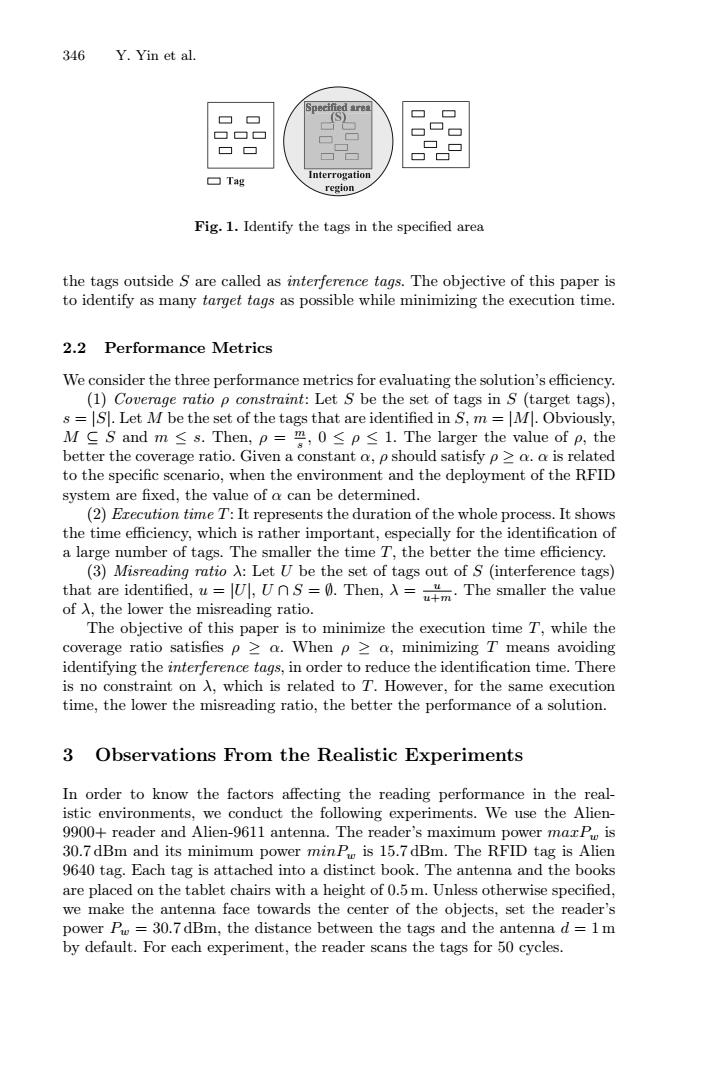正在加载图片...

346 Y.Yin et al. Specified area ▣▣ ▣▣ ▣回口 ▣▣ ▣▣ ▣Tag Interrogation region Fig.1.Identify the tags in the specified area the tags outside S are called as interference tags.The objective of this paper is to identify as many target tags as possible while minimizing the execution time. 2.2 Performance Metrics We consider the three performance metrics for evaluating the solution's efficiency. (1)Coverage ratio p constraint:Let S be the set of tags in S(target tags), s=S.Let M be the set of the tags that are identified in S,m =M.Obviously, M CS and m≤s.Then,p=g,0≤p≤1.The larger the value of p,the better the coverage ratio.Given a constant a,p should satisfy p a.a is related to the specific scenario,when the environment and the deployment of the RFID system are fixed,the value of a can be determined. (2)Erecution time T:It represents the duration of the whole process.It shows the time efficiency,which is rather important,especially for the identification of a large number of tags.The smaller the time T,the better the time efficiency. (3)Misreading ratio A:Let U be the set of tags out of S(interference tags) that are identified,UnS-0.Then,The smaller the value of入,the lower the misreading ratio. The objective of this paper is to minimize the execution time T,while the coverage ratio satisfies p>o.When p o,minimizing T means avoiding identifying the interference tags,in order to reduce the identification time.There is no constraint on A,which is related to T.However,for the same execution time,the lower the misreading ratio,the better the performance of a solution. 3 Observations From the Realistic Experiments In order to know the factors affecting the reading performance in the real- istic environments,we conduct the following experiments.We use the Alien- 9900+reader and Alien-9611 antenna.The reader's maximum power marPc is 30.7 dBm and its minimum power minP is 15.7 dBm.The RFID tag is Alien 9640 tag.Each tag is attached into a distinct book.The antenna and the books are placed on the tablet chairs with a height of 0.5 m.Unless otherwise specified, we make the antenna face towards the center of the objects,set the reader's power P=30.7 dBm,the distance between the tags and the antenna d=1m by default.For each experiment,the reader scans the tags for 50 cycles.346 Y. Yin et al. Fig. 1. Identify the tags in the specified area the tags outside S are called as interference tags. The objective of this paper is to identify as many target tags as possible while minimizing the execution time. 2.2 Performance Metrics We consider the three performance metrics for evaluating the solution’s efficiency. (1) Coverage ratio ρ constraint: Let S be the set of tags in S (target tags), s = |S|. Let M be the set of the tags that are identified in S, m = |M|. Obviously, M ⊆ S and m ≤ s. Then, ρ = m s , 0 ≤ ρ ≤ 1. The larger the value of ρ, the better the coverage ratio. Given a constant α, ρ should satisfy ρ ≥ α. α is related to the specific scenario, when the environment and the deployment of the RFID system are fixed, the value of α can be determined. (2) Execution time T: It represents the duration of the whole process. It shows the time efficiency, which is rather important, especially for the identification of a large number of tags. The smaller the time T, the better the time efficiency. (3) Misreading ratio λ: Let U be the set of tags out of S (interference tags) that are identified, u = |U|, U ∩ S = ∅. Then, λ = u u+m . The smaller the value of λ, the lower the misreading ratio. The objective of this paper is to minimize the execution time T, while the coverage ratio satisfies ρ ≥ α. When ρ ≥ α, minimizing T means avoiding identifying the interference tags, in order to reduce the identification time. There is no constraint on λ, which is related to T. However, for the same execution time, the lower the misreading ratio, the better the performance of a solution. 3 Observations From the Realistic Experiments In order to know the factors affecting the reading performance in the realistic environments, we conduct the following experiments. We use the Alien- 9900+ reader and Alien-9611 antenna. The reader’s maximum power maxPw is 30.7 dBm and its minimum power minPw is 15.7 dBm. The RFID tag is Alien 9640 tag. Each tag is attached into a distinct book. The antenna and the books are placed on the tablet chairs with a height of 0.5 m. Unless otherwise specified, we make the antenna face towards the center of the objects, set the reader’s power Pw = 30.7 dBm, the distance between the tags and the antenna d = 1m by default. For each experiment, the reader scans the tags for 50 cycles